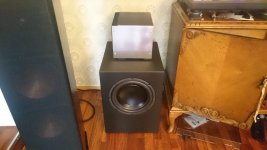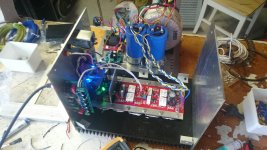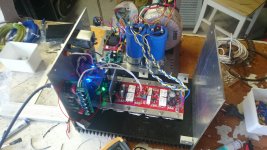That was probably me.
800Va 2x50v tranny giving me around 72v rails (I planned for 80v rails, but received the wrong transformers), 2x39000 uF caps, arc welder ops with 5p Sanken 2sa1295/2sc3264, njw0302/0281 drivers, spooky front end.
Jwilhelm and OS also had a subwoofer project. http://www.diyaudio.com/forums/solid-state/269935-subwoofer-class-ab-plate-amp.html
800Va 2x50v tranny giving me around 72v rails (I planned for 80v rails, but received the wrong transformers), 2x39000 uF caps, arc welder ops with 5p Sanken 2sa1295/2sc3264, njw0302/0281 drivers, spooky front end.
Jwilhelm and OS also had a subwoofer project. http://www.diyaudio.com/forums/solid-state/269935-subwoofer-class-ab-plate-amp.html
Attachments
Last edited:
That's a subwoofer x-over, the one Jwilhelm designed in the thread I posted.
I later took them out of my amps because I decided to use minidsp 2x4hd instead to make integration/adjustments easier and to high pass the mains.
I later took them out of my amps because I decided to use minidsp 2x4hd instead to make integration/adjustments easier and to high pass the mains.
Thanks again yngvejos!!!
Had a quick look at the thread and it seems doable.Will read the thread over the weekend.
I'm a bit torn at the moment.jwilhelm has been quite busy.I pm'ed him about a month back with regard to the work he's been doing with Valery(they also got a plate amp-NS Modular).I do like the concept and their protection scheme,but I would prefer to have a protection scheme without any programming(maybe something with dip switces to program different switch on/off times etc).Programming is not an issue for me as I have been busy with pc's for +- 2 decades on a hardware and software level.That being said I do concur that their protection scheme is the best diy one at the moment.Just would have been nice to have it "modular" as well so that you could only use the sections that you needed(and save space).This being diy,the protection scheme is daunting for the average diy layman and a chore for someone to fix with no programming experience.It reminds me a bit of the "plastic invasion"-lose(or it breaks) the remote and you're stuffed.Not saying ill never use it(I definitely will-much better option than stuff on the "bay").
Which reminds me-ill have to contact Valery for the etching files and relevant documentation.
Whew...decisions,decisions,decisions!!!
I remember evanc use the protection board and was quite happy with it.Mmm..I think ill go for that option now that I've got a friend who can etch the boards for me at the local college lab.Will cost me between 2 to 3USD per pcb as I only need to supply the blank copperclad boards.
Regards
phunk
Had a quick look at the thread and it seems doable.Will read the thread over the weekend.
I'm a bit torn at the moment.jwilhelm has been quite busy.I pm'ed him about a month back with regard to the work he's been doing with Valery(they also got a plate amp-NS Modular).I do like the concept and their protection scheme,but I would prefer to have a protection scheme without any programming(maybe something with dip switces to program different switch on/off times etc).Programming is not an issue for me as I have been busy with pc's for +- 2 decades on a hardware and software level.That being said I do concur that their protection scheme is the best diy one at the moment.Just would have been nice to have it "modular" as well so that you could only use the sections that you needed(and save space).This being diy,the protection scheme is daunting for the average diy layman and a chore for someone to fix with no programming experience.It reminds me a bit of the "plastic invasion"-lose(or it breaks) the remote and you're stuffed.Not saying ill never use it(I definitely will-much better option than stuff on the "bay").
Which reminds me-ill have to contact Valery for the etching files and relevant documentation.
Whew...decisions,decisions,decisions!!!
I remember evanc use the protection board and was quite happy with it.Mmm..I think ill go for that option now that I've got a friend who can etch the boards for me at the local college lab.Will cost me between 2 to 3USD per pcb as I only need to supply the blank copperclad boards.
Regards
phunk
That's a subwoofer x-over, the one Jwilhelm designed in the thread I posted.
I later took them out of my amps because I decided to use minidsp 2x4hd instead to make integration/adjustments easier and to high pass the mains.
I'm not really liking that crossover either. How do you like the Mini DSP system?
Thanks again yngvejos!!!
Had a quick look at the thread and it seems doable.Will read the thread over the weekend.
I'm a bit torn at the moment.jwilhelm has been quite busy.I pm'ed him about a month back with regard to the work he's been doing with Valery(they also got a plate amp-NS Modular).I do like the concept and their protection scheme,but I would prefer to have a protection scheme without any programming(maybe something with dip switces to program different switch on/off times etc).Programming is not an issue for me as I have been busy with pc's for +- 2 decades on a hardware and software level.That being said I do concur that their protection scheme is the best diy one at the moment.Just would have been nice to have it "modular" as well so that you could only use the sections that you needed(and save space).This being diy,the protection scheme is daunting for the average diy layman and a chore for someone to fix with no programming experience.It reminds me a bit of the "plastic invasion"-lose(or it breaks) the remote and you're stuffed.Not saying ill never use it(I definitely will-much better option than stuff on the "bay").
Which reminds me-ill have to contact Valery for the etching files and relevant documentation.
Whew...decisions,decisions,decisions!!!
I remember evanc use the protection board and was quite happy with it.Mmm..I think ill go for that option now that I've got a friend who can etch the boards for me at the local college lab.Will cost me between 2 to 3USD per pcb as I only need to supply the blank copperclad boards.
Regards
phunk
You've got a couple things backwards. I added the protection to my amp board to save space. The board size didn't change to accomplish this and it removed the need for external DC detection / speaker relay board. The protection portion can easily be bypassed if desired though.
Adding dip switches to get around programming makes troubleshooting much harder. With existing software troubleshooting is very simple. You can open a console window on your PC and watch the protection system in operation so you know exactly what's happening. It's quite simple to follow the documentation I've been providing as of late. If troubles arise that someone can't figure out, Valery or I are always available to answer questions.
People keep repeating that it's hard for a new builder to grasp digital circuits and programming, but that's actually quite ridiculous. Digital circuits are on or off. Analog circuits require much more math and theory to figure out, and many more years to fully understand. Software is only as hard as you make it. Arduino platform makes thing very simple to understand the software side of things and support in general for it is excellent for anyone trying to figure it out.
It looks like my last PM to you didn't go through. We do give out Gerber files for some of our designs, but some we simply have too much invested in to give away. The modular NS series of amplifiers were particularly expensive to design. It's not an easy layout. I've got hundreds of hours and thousands of dollars invested into developing these boards to where they are today. Schematics are available, but I'm not planning to release Gerber files for it.
How do you like the Mini DSP system?
Can't speak for yngvejos but I use a mini dsp 4x10 and like it quite a bit. For a long time I used the mini dsp just for the bass drivers but for the last few months have my system set up so that the digital music out of the computer goes right to the mini dsp and that controls all the amps. Maybe not better but different and super easy to make adjustments. This way I skip a D/A and an A/D conversion.
Can't speak for yngvejos but I use a mini dsp 4x10 and like it quite a bit. For a long time I used the mini dsp just for the bass drivers but for the last few months have my system set up so that the digital music out of the computer goes right to the mini dsp and that controls all the amps. Maybe not better but different and super easy to make adjustments. This way I skip a D/A and an A/D conversion.
This is something I would like to explore in the future. I've seen some neat designs here for DSP. I think it would be great to make crossovers simpler to design and adjust.
The mini dsp user interface is great. Some folks complain about the quality of their digital converters ... that they are skimping to keep the cost reasonable. I don't have enough comparative experience or knowledge to complain.
The mini dsp user interface is great. Some folks complain about the quality of their digital converters ... that they are skimping to keep the cost reasonable. I don't have enough comparative experience or knowledge to complain.
I was wondering how good the DA converters were. If I put a system together there wouldn't be cheap ones used.
One could output digital from the mini dsp and use their own DA converters. I wold need an 8 channel converter. I all ready have a twisted pear BIII. But would also need 8 channels of analogue volume control..... So much hardware.
I've been trying to think of a way to transmit audio wirelessly from a source to an amp without degrading the signal. DA conversion and volume control aren't too hard to figure out. Bryan Levin (LinuxWorks) has an excellent basis for controlling everything and having everything communicating together. The actual audio signal transfer is the part left to figure out. This may be as simple as adding a preamp board to the amplifier.
Check out Bryan's presentation at Burning Amp this year if you have some time. He's got some great ideas! https://www.google.ca/url?sa=t&rct=...z_Lf6bNT73Jzh7mKDa4oig&bvm=bv.144224172,d.amc
Check out Bryan's presentation at Burning Amp this year if you have some time. He's got some great ideas! https://www.google.ca/url?sa=t&rct=...z_Lf6bNT73Jzh7mKDa4oig&bvm=bv.144224172,d.amc
I was wondering how good the DA converters were. If I put a system together there wouldn't be cheap ones used.
They use the converters that are embedded in the chip which are reasonable but certainly not audiophile grade. I wonder if there is a market for a product with improved AD/DA converters? The DSP chip they use supports such a thing. The end product cost would be roughly $100 more. What do you think?
They use the converters that are embedded in the chip which are reasonable but certainly not audiophile grade. I wonder if there is a market for a product with improved AD/DA converters? The DSP chip they use supports such a thing. The end product cost would be roughly $100 more. What do you think?
I'm not sure if there's a market for it but it sounds like a neat project.
did anyone build the "apt 1" - like input stage that OS presented herein a while back?
if so, what did you think about it and did you add the baker clamp diodes back into the design?
thanks,
mlloyd1
if so, what did you think about it and did you add the baker clamp diodes back into the design?
thanks,
mlloyd1
I'm not sure if there's a market for it but it sounds like a neat project.
Yea, I suspect that you are right. I started a project using the new AKM converters a while back but got distracted. At the time it all looked pretty straight forward to do.
I'm not really liking that crossover either. How do you like the Mini DSP system?
The Mini DSP work great, only thing I don't like with it is noise. With nothing playing, I can hear a small hiss from my horn tweeters. I think this is because I use the analog inputs and attenuate the signal before it enters the minidsp. To reduce SNR I think it would be better to do the volume control on the outputs.
I could adjust volume in the minidsp instead, but I don't like to use volume controls without indication showing the actual setting.
The Mini DSP work great, only thing I don't like with it is noise. With nothing playing, I can hear a small hiss from my horn tweeters...
That's endemic of the converters and op amps internal to the DSP chip. Adding external converters gets around the noise. The digital circuit portion of the chip is inherently silent and quite useful.
We're way OT.. Maybe I should try the twisted pear BIII that I have after the mini dsp. I would need to work out 8 channels of IV conversion. I suppose I could use the digital volume control in the BIII. To be honest the computer stuff is hard for me. Not only are the ideas foreign but there is a whole "language" I don't know.
- Home
- Amplifiers
- Solid State
- Slewmaster - CFA vs. VFA "Rumble"


